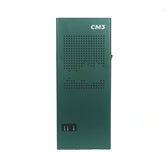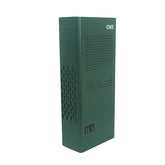How to Build: Cell Phone Jammer
Cell phone jammer is an electronic device that blocks the transmission of signals between a cell phone and a base station. By using the same frequency as a mobile handset, the cell phone jammer creates strong interference for the communication between the caller and the receiver. It is effective in blocking the transmission of signals from networks including UMTS, 3G, CDMA, GSM and PHS.
Cell phones operate on different frequency bands in different countries. For Canada, the 1900 MHz band is the primary band, especially for urban areas. 850 MHz is used as a backup in rural areas. The United States uses 850 and 1900 MHz bands, depending on the region. Europeans tend to use the GSM 900 and 1800 bands as standard. The Middle East, Africa, Asia and Oceania also use these frequency bands. In Russia and some other countries, local operators have licenses for the 450 MHz frequency to provide CDMA coverage.
The use of different frequencies makes it difficult to have a jammer for all frequencies. However, the formula mentioned below can be used to calculate the required values.
F = 1 / (2 * pi * sqrt (L1 * C1))
Depending on the frequencies to be blocked, the values of the inductor (L1) and of the capacitor (C1) can be modified.
For example, if the mobile phones in your area operate at 450 MHz, you need to generate 450 MHz with noise to act as a blocking signal. Now the cell phone receiver will not be able to understand which signal to receive. We managed to block cell phone signals.
Here, 450 MHz is the tuning frequency. Cell phone jammers for other frequency ranges are similarly designed. However, the signal range is very low. Thus, this circuit only works for a range of 100 m.
cell phone jammer circuit

The description:
For any jamming circuit, it is essential to have three important sub-circuits.
RF amplifier Voltage controlled oscillator Tuning circuit
3 circuits, when combined together, form an effective cell phone jamming circuit.
Work
The RF amplifier circuit includes transistor Q1, capacitors C4, C5, and resistor R1. This RF circuit amplifies the signal generated by the tuned circuit. The amplified signal is transmitted to the antenna via capacitor C6. It blocks DC and only allows the AC component of the signal to be transmitted.
When the transistor Q1 is conductive in the conductive state, the circuit tuned to the collector becomes conductive. The tuned circuit is composed of capacitor C1 and inductor L1. It acts like an oscillator with zero resistance. It produces a very high frequency with minimum damping.
When the circuit is turned on, voltage is stored in the capacitor. Once the capacitor is fully charged, it allows charge to flow through the inductor. When current flows through the inductor, it stores magnetic energy corresponding to the voltage across the capacitor. At some point the inductance reaches its maximum and the charge or voltage across the capacitor becomes zero.
Now the magnetic charge across the inductor decreases and the current charges the capacitor in opposite or reverse polarity. The process repeats and after some time the inductor charges the capacitor and becomes zero.
This process continues until an internal resistance is generated and the oscillations stop. Power for the RF amplifier is supplied by capacitor C5 to the front collector terminal C6. Capacitors C2 and C3 randomly generate pulses (noise) at the frequency generated by the tuned circuit.
The RF amplifier boosts the frequency generated by the tuned circuit. The frequency generated by the tuned circuit and the noise signal generated by capacitors C2 and C3 are combined, amplified and transmitted.
Required components
USED COMPONENT
Resistor R1 Emitter Loading
Resistance R2 Base Bias
Capacitor C1 Frequency generation
Capacitor C2 Feedback
Capacitor C3 Feedback
Capacitor C4 Noise Reduction
Capacitor C5 Coupling
Capacitor C6 Coupling
Capacitor C7 Decoupling
Transistor Q1 Amplification
Inductor L1 Frequency generation
Remark
This circuit can only block signals within 100 meters. The use of this type of circuit is prohibited and illegal in most countries. This circuit is also used in TV transmission and remote control toys. If the circuit is not working properly, try increasing the resistor and capacitor values in the circuit. Use the formula
F = 1 / (2 * pi * sqrt (L * C)).













